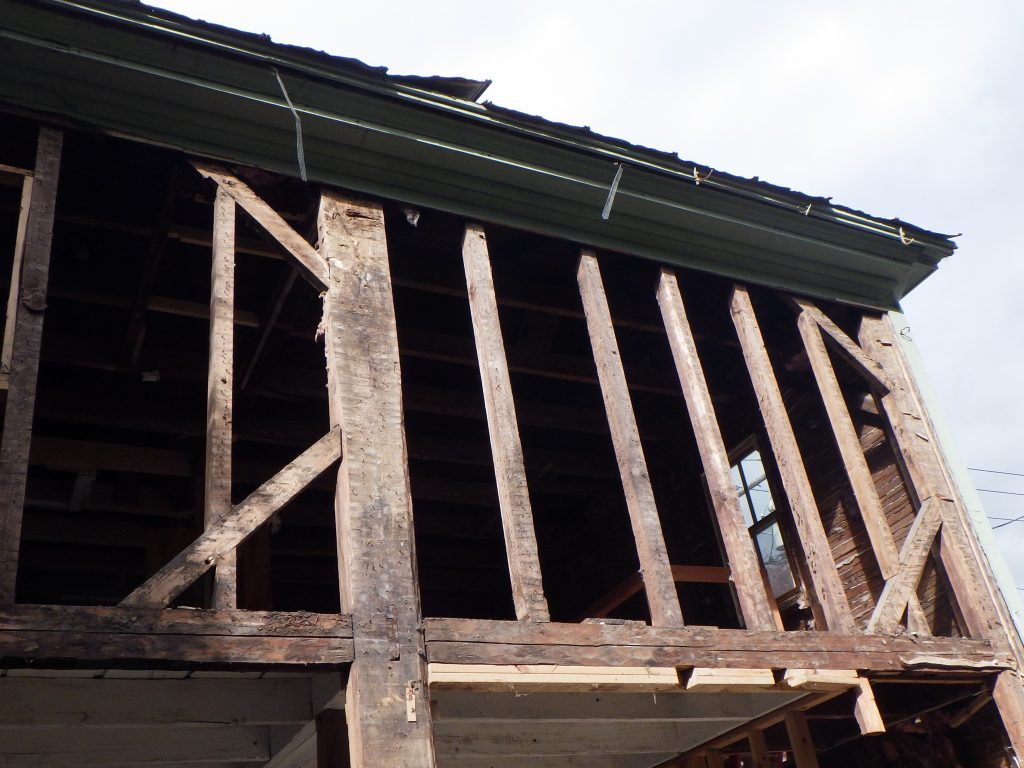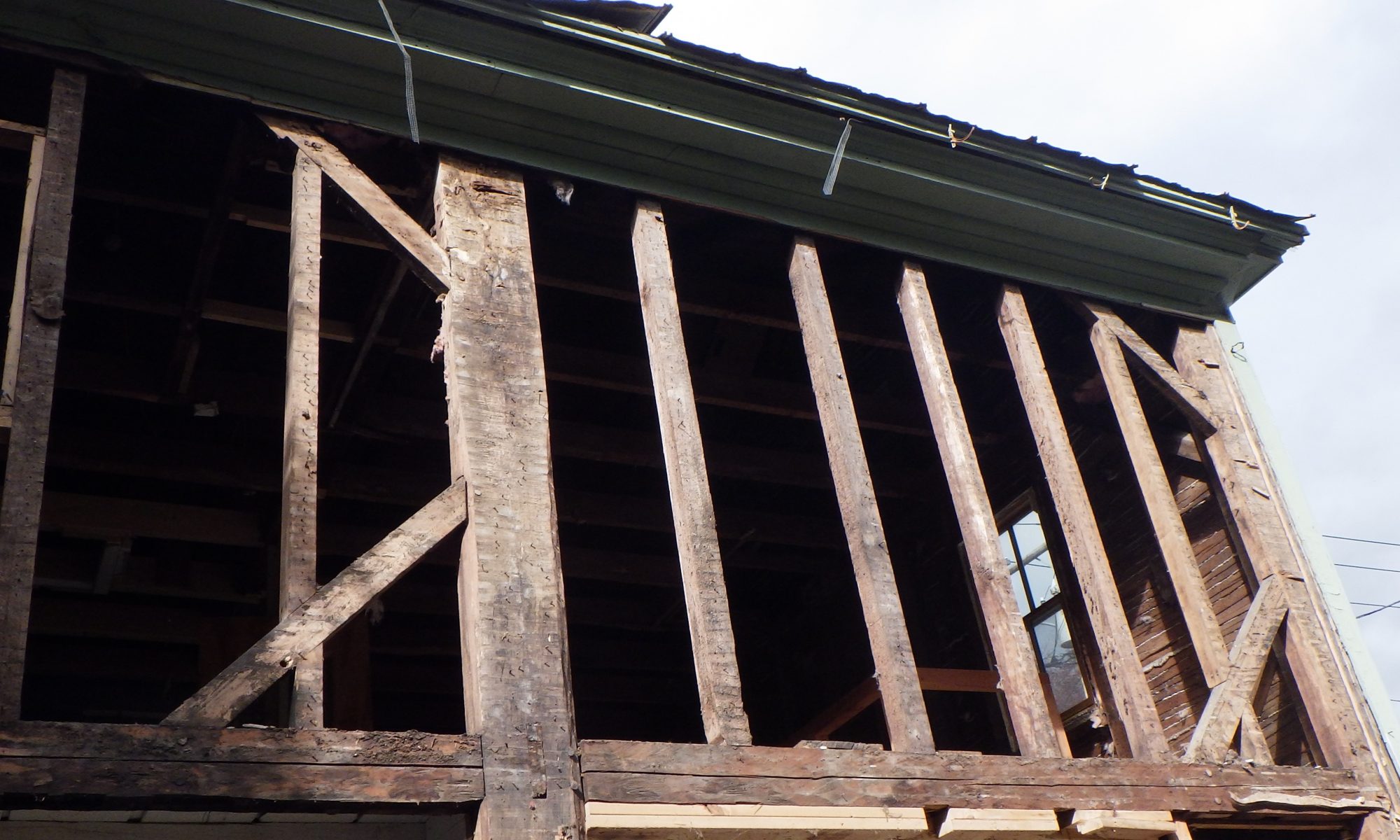
Many buildings constructed in the nineteenth century and earlier are timber-frame structures. Builders used plentiful old-growth timber and adapted European construction methods to the new world. While the behavior of timber braced frames are fairly complex, these buildings were built without the aid of structural engineering calculations and design standards. To ensure that the building was safe and useable, the builders could not deviate too far from their prior experience. As a result, historical timber-frame buildings follow common forms and floor plans. Even as light wood-frame construction began to replace timber framing in the late nineteenth and early twentieth centuries, vestiges of timber framing practice persisted.
While traditional timber frame structures and later light-frame wood structures have outward similarities, their structural behavior differs significantly, resulting in light-framed structures being more easily modified. What would be straightforward renovations in conventional light-frame wood construction may introduce complications requiring the involvement of a structural engineer in a timber frame structure.
Timber vs. Conventional Framing
Timber-frame construction makes use of relatively large wood elements that are semi-rigidly connected, often using mortise and tenon joints secured with wooden pegs. Certain connections would be reinforced with knee braces received by mortises in the connected elements. Due to the rigidity of the frame, timber frame structures could be relatively stable while they were built despite consisting of relatively few elements. Modern conventional and engineered wood construction is made up of assemblies like walls and floors consisting of relatively slender wood elements and sheathing panels that are connected using large quantities of nails or screws. When completed, the assemblies are stable, but the numerous elements used to construct them are individually relatively unstable until they are incorporated into the completed assembly.
Timber frames and modern light framing also differ in how they are redundant. Most timber frame buildings are enclosed with wood plank sheathing nailed to light wood elements spanning between the main timbers. This wall construction results in an unintentionally redundant structural system. Gravity load is primarily resisted by the timber beams and posts, but the wall studs supporting the sheathing transmit some portion of the gravity load. The lateral load resistance of the timber frame is augmented by the in-plane shear resistance of the sheathing. The redundancy in timber frame construction increases safety and durability. However, quantifying the contributions of these unintended load paths is fraught with uncertainty. A timber frame will not perform as expected if a post or beam is compromised. And the redundancy of the walls does not typically carry to the floors and the roof. In contrast, light wood framing inherently contains numerous elements and connections resulting in a high degree of redundancy within assemblies.
Constraints of Timber Frames
Renovations to a timber frame building are significantly constrained by the timber frame. Since load is concentrated in relatively few main elements, alterations like modifying wall openings can involve substantial shoring and reframing to establish a load path around an opening that conflicts with elements of the timber frame. Without an engineered design to transfer load around the opening, the gravity or lateral load-resisting performance of the structure could be compromised. In contrast, openings in light-framed walls can often make use of redundancy within the wall assembly, allowing individual elements to be cut or reinforced while maintaining the structural integrity of the wall. These alterations can often follow prescriptive code provisions, such as the practice of maintaining the wind load capacity around a wall opening by replacing studs interrupted by an opening with full-height studs on the sides. While the need for the wall to transmit in-plane lateral loads will limit the location and size of the opening, these constraints are less severe than that of a timber post.
Similarly, the floor plan of a timber frame building is constrained by the framing. Beams generally span between posts and joists span between beams. Openings within a joist span are harder to make because the joists are typically larger, more irregular and wider spaced than in light-frame construction. Timber frame buildings sometimes contain interior posts that transmit floor loads into the basement that are embedded in walls. A renovation intended to open the floor plan may necessitate removing an interior post. This is likely to require a large engineered beam, which may encroach unacceptably below often already low ceilings. A load path for the beam must be established. If the existing exterior post cannot support the additional load, there will not likely be space to fit the beams’s posts in the walls, and the posts may need their own foundations. Substantial openings in interior light-frame bearing walls also require engineered beams and load paths, but light-frame floors typically distribute load more uniformly, reducing bending load effects. Posts for these beams usually can be fit into the exterior wall cavities without disrupting more than one wall stud. Beams supporting the attic floor also tie the posts together to resolve thrust at the top of the posts due to roof loads. Removing one of these beams to make an opening in the floor results in the wall bowing outward at the eave, potentially damaging and even destabilizing the affected post. In light-frame construction, floor openings adjacent to walls can usually be made by reinforcing elements forming the perimeter of the opening.
Understrength Elements and Connections
The builders of timber frames did not have the advantage of theories of structural analysis and engineering mechanics. Beams are commonly relatively wide, but similar in depth to the joists. Consequently, they are often undersized by modern standards. A common connection of floor joists to beams consists of the joist ends carved to form “cogs” to fit in notches in the top of the beam. The detail further reduces the bending strength of floor beams, especially in upward bending as may occur if supplemental posts are used to mitigate floor sag. Upper-floor beams that split the width of the floor into two spans, sometimes frame into end girts of the same size spanning the full width. The combination of a concentrated midspan load with a mortise and tenon joint results in the greatest load effects and the weakest section of the end girt coinciding. The performance of the timber frame elements and connections can be demonstrated by being in service for decades, but that performance may rely on an unintended load path to share the load, such as wall studs resisting gravity loads. Modern building codes generally do not allow alterations that reduce the structural safety of a building below what is tolerated for new buildings. It can be difficult or impossible to demonstrate by analysis that loads on elements of a timber frame can be increased by a change in occupancy (even residential sleeping to nonsleeping) or the removal of secondary elements. Renovations of timber frames are therefore more likely to require engineered strengthening of existing elements and connections.
Field Conditions
In renovation work, field conditions are often encountered that compromise the structure and must be remedied or worked around. Both timber frame and light-frame wood buildings are susceptible to damage from decay, installation of mechanical and electrical systems and prior poorly executed alterations. With light framing, the damage is more likely to be contained and usually can be repaired by adding elements to effectively replace impaired elements. Damage to timber frames is harder to fix. A decayed post cannot be sistered practically due to its size and the obstruction presented by beams and braces. If a girt or floor beam has been hollowed out to allow plumbing to pass between floors, load typically cannot be shared reliably with redundant elements and repair can be difficult to make. The pegs securing certain connections are inaccessible in the completed structure, precluding in-kind repairs without some level of disassembly. For timber frame structure renovations, it is more critical to be proactive about investigating existing conditions and establishing contingency plans to resolve them to reduce the potential for delays and redesign during construction.
Historical timber frame structures are a finite resource that should be conserved to the extent practicable. Maintaining the structural integrity of the structures is vital to their preservation. Renovations that are sensitive to the form and function of a timber frame building allow it to continue to serve a viable purpose. However, expecting a historical building to have the functionality of a new building is folly. While it may be possible to engineer modifications to a timber frame to accommodate open floor plans or large windows, usually the owner would be better off with new construction designed to look historical.
Light framing supplanted timber framing in the construction of common buildings because it is a more flexible construction type that requires less effort and skill to design and construct. Consequently, light-frame wood buildings are more easily altered, thus permitting more flexibility in planning a renovation. Timber frames impose more structural constraints and are more likely to be impacted by deterioration or damage. Executing a renovation of a timber frame building requires a design and construction team knowledgeable in the behavior of timber frames. This begins with retaining an architect who can develop plans sensitive to the constraints and historical nature of the original construction. A general contractor with timber frame experience is vital, especially if repairs are needed, because of the difference in behavior and construction of timber frames and modern convention light framing. Timber frame projects involving structural alterations also need a structural engineer, preferably one well-versed in historical construction methods and can assess uncertain natural materials, empirically designed construction details and will provide effective design solutions that preserve as much of the historical function and fabric of the building as possible.
The information and statements in this document are for information purposes only and do not comprise the professional advice of the author or create a professional relationship between reader and author.
This content was originally posted to the website of Richard J. Driscoll, Consulting Engineer.


